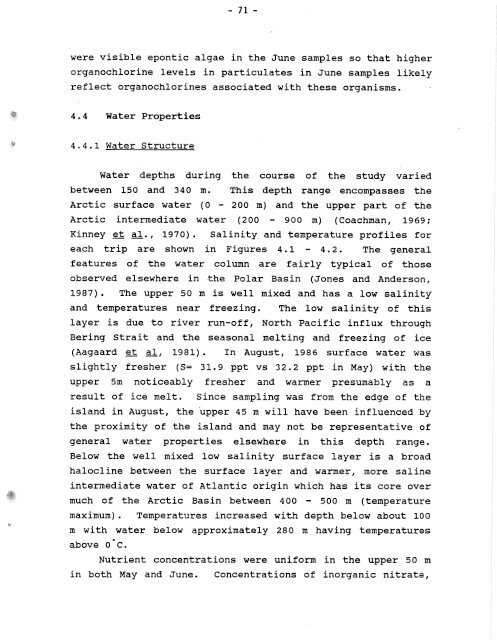Distribution of Chlorinated Hydrocarbon Pesticides and PCBs in the ...
Distribution of Chlorinated Hydrocarbon Pesticides and PCBs in the ...
Distribution of Chlorinated Hydrocarbon Pesticides and PCBs in the ...
Create successful ePaper yourself
Turn your PDF publications into a flip-book with our unique Google optimized e-Paper software.
were visible epontic algae <strong>in</strong> <strong>the</strong> June samples so that higher<br />
organochlor<strong>in</strong>e levels <strong>in</strong> particulates <strong>in</strong> June samples likely<br />
reflect organochlor<strong>in</strong>es associated with <strong>the</strong>se organisms.<br />
4.4 Water Properties<br />
4.4.1 Water Structure<br />
Water depths dur<strong>in</strong>g <strong>the</strong> course <strong>of</strong> <strong>the</strong> study varied<br />
between 150 <strong>and</strong> 340 m. This depth range encompasses <strong>the</strong><br />
Arctic surface water (0 - 200 m) <strong>and</strong> <strong>the</strong> upper part <strong>of</strong> <strong>the</strong><br />
Arctic <strong>in</strong>termediate water (200 - 900 m) (Coachman, 1969;<br />
K<strong>in</strong>ney & Q., 1970). Sal<strong>in</strong>ity <strong>and</strong> temperature pr<strong>of</strong>iles for<br />
each trip are shown <strong>in</strong> Figures 4.1 - 4.2. The general<br />
features <strong>of</strong> <strong>the</strong> water column are fairly typical <strong>of</strong> those<br />
observed elsewhere <strong>in</strong> <strong>the</strong> Polar Bas<strong>in</strong> (Jones <strong>and</strong> Anderson,<br />
1987). The upper 50 m is well mixed <strong>and</strong> has a low sal<strong>in</strong>ity<br />
<strong>and</strong> temperatures near freez<strong>in</strong>g. The low sal<strong>in</strong>ity <strong>of</strong> this<br />
layer is due to river run-<strong>of</strong>f, North Pacific <strong>in</strong>flux through<br />
Ber<strong>in</strong>g Strait <strong>and</strong> <strong>the</strong> seasonal melt<strong>in</strong>g <strong>and</strong> freez<strong>in</strong>g <strong>of</strong> ice<br />
(Aagaard & d, 1981). In August, 1986 surface water was<br />
slightly fresher (S= 31.9 ppt vs 32.2 ppt <strong>in</strong> May) with <strong>the</strong><br />
upper 5m noticeably fresher <strong>and</strong> warmer presumably as a<br />
result <strong>of</strong> ice melt. S<strong>in</strong>ce sampl<strong>in</strong>g was from <strong>the</strong> edge <strong>of</strong> <strong>the</strong><br />
isl<strong>and</strong> <strong>in</strong> August, <strong>the</strong> upper 45 m will have been <strong>in</strong>fluenced by<br />
<strong>the</strong> proximity <strong>of</strong> <strong>the</strong> isl<strong>and</strong> <strong>and</strong> may not be representative <strong>of</strong><br />
general water properties elsewhere <strong>in</strong> this depth range.<br />
Below <strong>the</strong> well mixed low sal<strong>in</strong>ity surface layer is a broad<br />
halocl<strong>in</strong>e between <strong>the</strong> surface layer <strong>and</strong> warmer, more sal<strong>in</strong>e<br />
<strong>in</strong>termediate water <strong>of</strong> Atlantic orig<strong>in</strong> which has its core over<br />
much <strong>of</strong> <strong>the</strong> Arctic Bas<strong>in</strong> between 400 - 500 m (temperature<br />
maximum). Temperatures <strong>in</strong>creased with depth below about 100<br />
m with water below approximately 280 m hav<strong>in</strong>g temperatures<br />
above O'C.<br />
Nutrient concentrations were uniform <strong>in</strong> <strong>the</strong> upper 50 m<br />
<strong>in</strong> both May <strong>and</strong> June. Concentrations <strong>of</strong> <strong>in</strong>organic nitrate,

















